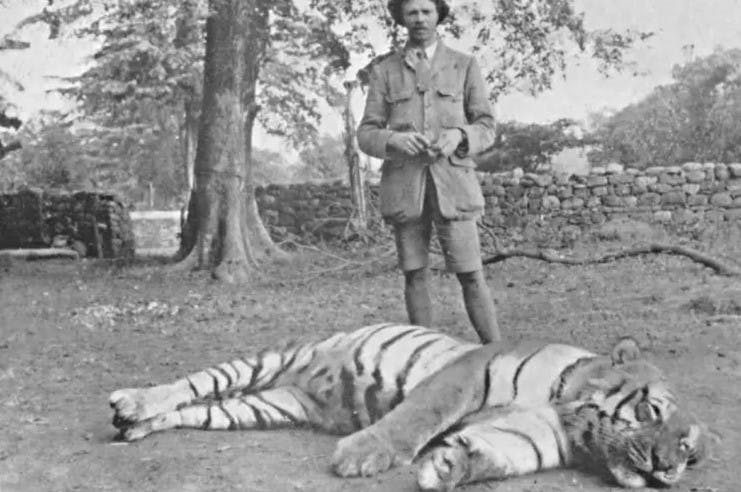TERROR UNLEASHED IN THE HIMALAYAN FOOTHILLS
In the Himalayan foothills at the turn of the 20th century, an unsettling quiet fell upon a string of villages dotting the forested landscape. An ominous chill took hold as locals ceased venturing beyond their doors. Those who dared set foot outside risked a gruesome demise with little warning. For a ruthless serial killer lurked in the shadows – not a deranged human, but a wounded tigress with a taste for human flesh. Below we dive into this fascinating story of the maneater of Champawat.
What drove the “Tiger Queen’s” bloody 7-year rampage across northern India? How could one elusive beast evade capture and spread such horror? And who finally ended her reign of terror that claimed over 400 lives? Hers is a harrowing tale of the complex relationship between man and nature’s apex predators. One that still haunts the region over a century later.


NEPAL’S PHANTOM KILLER
Our grim story begins in the western hills of Nepal circa 1898. In the quiet district of Rupal, the first faint stirrings of unease took hold as villagers started disappearing into the forest. The occasional mauling was known to happen in these parts. But soon the attacks accelerated at an alarming pace. Twenty here. Fifty there. Bodies turned up mauled and half-eaten. It became apparent that no one who ventured near the treeline was safe.
Hunting parties were dispatched to track down the killer lurking in the shadows. But the cunning beast outwitted them at every turn, evading traps and gunfire. Her phantom-like presence continued to haunt the periphery of remote villages lining the hillsides. Speculation brewed that multiple maneater tigers were to blame for the attacks spread over such a vast territory.
In reality, the killer was frighteningly real – and shockingly just a single female Bengal tiger. Even with hundreds perishing, she remained maddeningly invisible. But simply by listening for the spine-chilling roar echoing from the forests, the villagers knew…the maneater was still out there. And she was famished.

DRIVEN BY HUNGER ACROSS THE BORDER
By 1905, the elusive tigress had claimed over 200 lives in western Nepal. Finally, the Nepalese army joined the hunt in full force. Soldiers scoured the forests as the kill count rose. After months of relentlessly tracking their forests, the army patrols tightened the noose, denying the tiger access to prey. Starving her out at last, they pressed the tigress downhill toward the Sarda River and the Indian border.
And so began the most notorious killing spree in history. Crossing into India’s Kumaon district, the crippled Bengal tiger found a new hunting ground teeming with vulnerable prey. She adapted quickly, traveling 20 miles between kills, cleverly avoiding the villages roused by her latest victim. Reports trickled in as the tigress claimed three…five…eight lives a day. Mostly women and children foraging the forests fell prey.
In this way, the elusive serial killer evaded the bounty hunters dispatched to claim the 1,000 rupee reward on her head. The villages under attack, their livelihoods paralyzed by fear, grew desperate for a savior. Little did the settlers know, the key to their salvation lay in a chance encounter some years prior.
JIM CORBETT VS THE TIGER QUEEN
As the most prolific hunter in the region, Jim Corbett was no stranger to tracking man-eating big cats. Years earlier, he had actually crossed paths with the Champawat tiger before her taste for human flesh fully developed. While walking through the forest, Corbett startled the tigress feeding on a buffalo calf. Avoiding his rifle fire, the tiger fled and vanished, leaving a lasting impression on Corbett.
Now the settlers’ cries for help echoed as a grim calling, and Corbett felt compelled to respond. Upon arriving in Champawat district in 1907, he recognized the tiger’s trademark killing style from the casualties still mounting. Though Corbett preferred to hunt alone, even he knew the clever Champawat maneater demanded special tactics.
For the first time, Corbett organized a beat of over 300 villagers to help corner his crafty adversary. Driven from her lair toward the waiting guns, the trail of blood left by her latest kill allowed the team to anticipate her movements. After declaring he would “either shoot the tigress or the tigress would shoot me,” Jim Corbett readied for the confrontation of a lifetime.
THE HUNT CLIMAXES AT DUSK
On a fateful spring evening in 1907, the manhunt reached its dramatic climax. Lured by gunshots and cries echoing through the forest, the maneater emerged from the brush at dusk. But rather than fleeing the commotion, she fearlessly charged head-on toward Jim Corbett and the local tahsildar.
Corbett’s first shots struck the frenzied tigress in the chest and shoulder. But still she thundered closer, hellbent on taking Corbett with her. With his final bullet, Corbett caught her limping charge in the foot just 20 feet away. The tigress crashed to the forest floor, her long reign of terror definitively over.
In a cruel twist of irony, examination of the slain tiger revealed that the upper and lower canine teeth on her right had been shattered long ago by a careless poacher’s bullet. No longer able to catch natural prey, she was left weakened and starving until discovering an easier meal – humans. Forced into desperation by her injury, over seven years she had killed and eaten over 400 men, women and children.
At long last, Jim Corbett had freed the terrified villages of northern India from the bloody clutches of the “Tiger Queen.” But for Corbett, still holding the spent rifle that felled the maneater, the socioeconomic plot lines tying hunters, habitat loss and starving predators began coming into sharp focus.
A NEW MISSION TAKES SHAPE
In the years following his successful hunt, Jim Corbett transitioned from celebrated hunter into a devoted conservationist. Haunted by the fate of the crippled tigress that claimed so many lives, Corbett grew wary of unchecked trophy hunting devastating India’s Bengal tiger population.
He pivoted from stalking wildlife through gun sights to capturing tigers’ glory through his camera lens instead. The renderings would illustrate Corbett’s new mission – raising awareness about India’s vanishing habitats and the protection of endangered species, especially its national icon – Panthera tigris tigris.
Corbett played an instrumental role in establishing India’s first national park, Hailey National Park, in 1936. Today known as Corbett Tiger Reserve, the preserve promotes conservation of the Bengal tiger and countless other species.
In this way, the trauma left by the Champawat maneating tiger catalyzed Corbett’s calling to defend India’s great cats rather than hunt them. And Corbett Tiger Reserve remains a living legacy to that transformation today.
THE ENDURING LEGACY OF THE CHAMPAWAT MANEATER
The remarkable 12-year saga of the Champawat maneater tiger came to a decisive end that evening in 1907 beneath Jim Corbett’s smoking rifle. But the incredible events spawned a legend that still echoes through the region over a century later.
The sheer audacity displayed by the wounded tigress inspires both shock and grudging awe. That even a handicapped apex predator could so easily unleash havoc highlights the delicate balance between man and beast. And Corbett’s own reckoning shows how profoundly confronting such forces can reshape one’s purpose entirely.
So the tragic events that unfolded in the shadows of the Himalayan foothills still provide relevant lessons today. From the fruits borne of Corbett’s tireless activism to the humbling might displayed by nature’s perfect hunters when backed into a corner, the echoes still resonate. And the name Champawat is sure to endure for centuries more as a cautionary tribute to the most prolific maneater ever known.
📈😲Additional Facts
420
Bengal tigers can reach up to 9 feet long and 310 pounds. However, females typically max out at 8 feet and lower weights compared to males. These big cats can consume over 30-40 kg or 70 to 90 lbs of meat in one meal and feel no need to hunt for up to 3 weeks.
200 Square Miles
Though seen as lazy, resting much of the day, tigers can travel large territories up to 200 square miles to hunt and patrol their domain.
